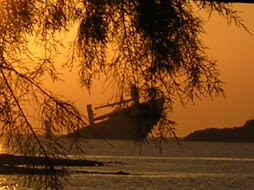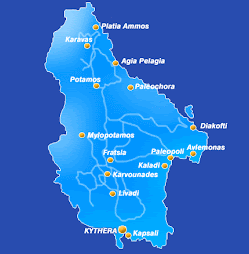Kythera is the crossroad of Mediterranean cultures.
It was always the hospitable shelter of corsairs, colonists, ascetics and persecuted. Kythera was inhabited during the Neolithic age and later.
Many potsherds from the copper age, early - Helladic and early - Minoan ages are "sleeping" under the earth of Kythera. Others lying on the surface, are watching the eternal course of sun and moon in the sky.
Near the twentieth century B.C. Minoans dominate on the island and govern the surrounded area. One of the earliest Minoan colonies, is located in Kastri, known today Paleopoli.
Skandia is the seaport of the colony.
In the mountain of Agjos Georgios, archaeologists found the traces of Minoan temple and drinking-offering vessels, stone-artefacts, cupreous figurines.
Phoenicians keep a colony on the island at the 15th century B.C. processing purple (porphyra) to produce the deep red colour that they use in clothes. So they have laboratories for the purple treatment. Ancient Kythera is named Porphyris or Porphyrousa these years.
According to Herodotus, the foundation of a temple dedicated to Aphrodite is owed to Phoenicians who imported the adoration of an alike goddess from the east.
After Minoans and Phoenicians there were Myceneans who came in the island at the 14th century. Although Spartans possessed the Kythera island since the 6th century B.C. till the Classic years, Athenians came enough times to claim Kythera, more specifically at the season of Peloponnesian Wars.
The continuous changes of possession of Kythera from Athenians and Spartans will lead to peace in 421 B.C. In the region Kastri a lot of Athenian and Spartan potsherds testify the fact. Apart from Aphrodite, Dioscouri are worshipped on Kythera.
The age of Macedonians follows and afterwards the Romanian Empire. In 365 A.C. an earthquake affected the island with dramatic geomorphic changes in the region of Skandia.
Since the 6th century Kythera, as all Mediterranean area, belong to Byzantium and the intense religiosity appears at least in three hundred monuments and temples. In 1000 A.C. the island is depopulated. The Evdemonogiannis families from Monemvasia come in the island after one century and remain the only dominants until 1204 .
They built the settlement of Agios Dimitrios in Paleochora. An old legend says that Paleochora had 365 temples, one for each day of the year. Powerful Venetians blaming Kythera with other islands and regions of hellenic space.
The Venetian state installs the Venieri family in the island which governed it for many years. In 1238 Nikolaos Evdemonogiannis is looking the Venetian sovereignty in the regions, weds his daughter with the Venetian feudal lord of Crete Mark Venier. However, Kythera remain nominally in the sovereignty of Venice . By the emperor of Byzantium Michael Paleologos Kythera is recovered by Constantinople . Monemvasians with the members of the family Notaras at the head, impose the anti-Latin policy low of byzantine emperor in 1275. They restore the island in the Byzantine control and turn away the Venieri family .
Later Venetians come back making war in all the Aegean sea . Notaras retire. During the Venetian age on Kythera the orthodox faith isn’t oppressed. Venetians respected the religious culture of the island. In 1470 the island had only 500 residents who live in poor years. The population reaches the 4000 residents in the 16th century.
The residents in order to protect themselves, are organised in three central points on the island. The castles of Kythera(Chora), Agios Dimitrios (Paleochora) and Mylopotamos shelter and protect the population.
In 1537 the janissary Hayredin Barbarossa, one of the most terrible pirates of Mediterranean destroys, sacks Paleochora that was drowned in blood. The 17th century a lot of refugees come from Crete in the island, carrying customs, habits and culture. In 1715 Turks touch upon Kythera. They do not stay more than three years. During the last years of Venetian sovereignty in the island the residents population will reach the 7500. The island belongs to Venetians up to the catalysis of the state in 1797.
In 1798 Frenches, who are in the highlight of their glory, come to Kythera. Afterwards, Russians and Turks will ally in order to conquer the island and control the seas. In 1798 a strong earthquake, will destroy everything in the Kastri region, Skandia.
In 1809 English regenerate the island with tens of works, but oppress the Greek culture. It is in 1815 that Kythera with all the Ionian islands will constitute the United State of Ionian Islands and the capital is Corfu .
In 1864 the Ionian islands get linked to independent Greece . In 1903 a devastating earthquake, with seismic focus in Mitata, levels everything in the wider region. In 1917 Kythera existed also as "Autonomous Administration" for a short interval of time. In the Second World War Kytherians participated dynamically in the National Resistance. Rebel forces are organised in Potamos village limits the control of the island against the Germans. Since 4 September 1944 the island is the first region of Greece that is released. However, it depopulates. Most young people emigrate, to Australia and the United States of America .
giovedì 27 marzo 2008
Voyage to Kythira
A Voyage to Kythera means to many people a nostalgic wandering in exotic and dreamt places, just like in Wattaeu's romantic painting "The Embarkment for the Island of Kythera" .
The myth of Kythera, also known as the island of love, goes far back in the traditions of France and Italy. Voyage to Kythera, a difficult task, an island to which pilgrims set out but never succeed in arriving.
As long as it stays far, preserves its distant spark as a land of eternal destination, impossible dream and ideal beauty. Since ancient times Kythera is related to the myth of Aphrodite, the goddess of beauty and Eros. There it lies in her heavenly haze as a land as much utopic as well real and within reach.
Reality brings us to a place of myth, not so distant as it is presented in the tradition of literature, but with its marks strong. It is enough to walk on the clear beaches and watch the sunset, for this to be felt.
Somewhere there, the sky meets the sea painting it with its scarlet reflections and perhaps someone could witness the birth of Aphrodite, daughter of Uranus and Sea.
One might even see a piece of the never ending Sky (Uranus) fall, due to the mighty slash from Cronos, in the life-giving Sea, who wraps it with her froth. Perhaps one could also feel the distinct breeze of Zephyros, who rendered Aphrodite to the world and prepared her to take her place in the mighty mythological Olympus
The myth of Kythera, also known as the island of love, goes far back in the traditions of France and Italy. Voyage to Kythera, a difficult task, an island to which pilgrims set out but never succeed in arriving.
As long as it stays far, preserves its distant spark as a land of eternal destination, impossible dream and ideal beauty. Since ancient times Kythera is related to the myth of Aphrodite, the goddess of beauty and Eros. There it lies in her heavenly haze as a land as much utopic as well real and within reach.
Reality brings us to a place of myth, not so distant as it is presented in the tradition of literature, but with its marks strong. It is enough to walk on the clear beaches and watch the sunset, for this to be felt.
Somewhere there, the sky meets the sea painting it with its scarlet reflections and perhaps someone could witness the birth of Aphrodite, daughter of Uranus and Sea.
One might even see a piece of the never ending Sky (Uranus) fall, due to the mighty slash from Cronos, in the life-giving Sea, who wraps it with her froth. Perhaps one could also feel the distinct breeze of Zephyros, who rendered Aphrodite to the world and prepared her to take her place in the mighty mythological Olympus
Are you looking for a Natural Break?
Kythira is the island, the door, where western and eastern culture meet each other.
Where Balcanian mountains finish, just in front of the deepest Mediterannean waters
there is a piece of paradise with pins, charming monastery, ancient villages and
astonishing deserted beaches.
If you dream about empty beautiful landscapes, traditional hand-made products and cuisine,
if you dream about history and poetic atmospheres, Kythira is your place to be.
Sometimes dreams come true in a very simple and natural reality.
Naturalmente (naturally in Italian language) is just waiting for you.
http://www.naturalmentevillas.com
Where Balcanian mountains finish, just in front of the deepest Mediterannean waters
there is a piece of paradise with pins, charming monastery, ancient villages and
astonishing deserted beaches.
If you dream about empty beautiful landscapes, traditional hand-made products and cuisine,
if you dream about history and poetic atmospheres, Kythira is your place to be.
Sometimes dreams come true in a very simple and natural reality.
Naturalmente (naturally in Italian language) is just waiting for you.
http://www.naturalmentevillas.com
Iscriviti a:
Post (Atom)


